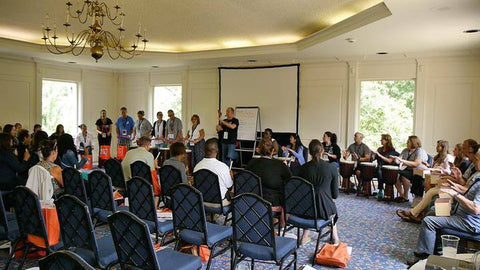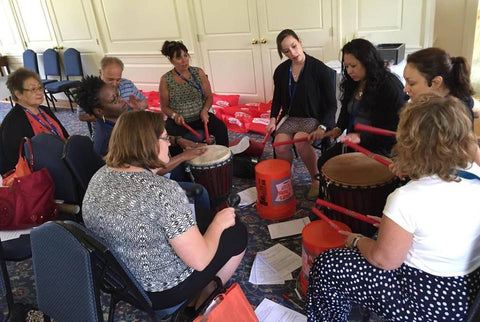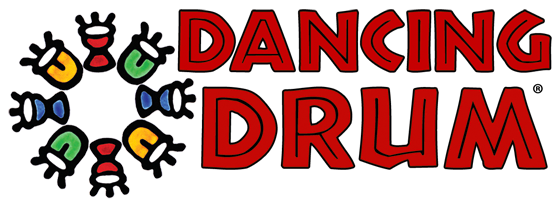- Continue Shopping
- Your Cart is Empty
Great NEWS! cARTwheels + Dancing Drum
Great news! Dancing Drum has been selected as a Teaching Artist for cARTwheels, North Carolina Arts Council’s Arts in Education Grant Program!
This means that you can access funding through the NC Arts Council to bring Dancing Drum your school. There is a process for applying for funding. You can learn more at this link:
https://www.ncarts.org/grants-resources/grants/grants-organizations/cartwheels-program-grants
We are thrilled to be a part of North Carolina’s rich arts community and look forward to reaching more students across the state with our new partners at cARTwheels!
Summer 2022 Teacher Training Intensive Was a Hit!
On August 15th, Dancing Drum hosted 40 music teachers from across the state at our Summer Teacher Training Intensive in Asheville, North Carolina. It was a fun, music-packed day, and we shared a wide range of activities and resources to enrich PreK-8 music programs through hands-on drumming. Check out a video of the day below!
If you’re interested in bringing a similar Professional Development program to your school district, just let us know!
New Elementary Music PD Added: That Sounds Great! Elementary Drumming in 3/4 and 6/8
Bring the magic of drumming in 3/4 and 6/8 time signatures to your music classroom! In this highly interactive session, attendees will learn and play beginning to advanced drum rhythms designed for success and fun! Expand your student's drumming skills as they explore the fascinating world of 3/4 and 6/8! View full article →Upcoming Professional Development Conferences in IL and NC
We look forward to bringing Dancing Drum to state music education conferences in North Carolina and Illinois this school year! Here are a few more details about the hands-on, interactive sessions that will be led by our Musical Director, Mr. Steve... View full article →Successful West African Drumming in the General Music Classroom
West African drumming is a fantastic experience I recommend for all music educators to expand their musical repertoire. When I traveled to West Africa, I was amazed and inspired by the depth of rhythmic and melodic expression that exists in this art form. I say melodic because the rhythms are taught in the form of a song of various pitches that the drum can make. All of the master drummers I studied with would sing the rhythms to me with their own language or “drum talk.” I found it was much easier to learn and retain these rhythms by singing them while I was playing them.
Upon my return to the US, Dancing Drum co-creator Lindsay Rust and I developed a version of this technique called Rhythm Phonics, which uses drum sounds, words, and syllables to teach rhythmic patterns. The Drum Sounds are distilled into two essential tones: a low sound called “Boom” and a high sound called “Ba”. These correspond to the Bass and Tone sound of the djembe. There is a third, higher slap sound played on the djembe, but that sound is too difficult for most K-8 students to make, so we do not use it in our general music programs.
The Words & Syllables of Rhythm Phonics are a verbal piece or song written so that the syllables of the phrase match the notes in the rhythm pattern. As this is a tool for learning, memory, and retention this phrase doesn’t necessarily have to originate from the West African source; we create a phrase that students can remember easily. We have used this two-part Rhythm Phonics method over the last decade in all of our Dancing Drum programs with incredible success.
When you hear West African drumming, there are so many rhythmic layers and syncopations happening that it is often difficult to know how to teach it successfully. Many music teachers have expressed to me how amazing it was to play a West African drumming piece at a conference session with all of their colleagues, but find it very difficult to replicate that experience in the general music classroom. Inside the polyrhythmic layers of a West African drumming arrangement is a pattern that contains its essence or theme and is usually the first rhythm taught to establish the foundation of the piece. In Dancing Drum, we call this the Signature Rhythm and I recommend starting your lesson with this pattern.
To begin, introduce the Signature Rhythm verbally using Rhythm Phonics. After your students can sing this rhythm, have them play it in unison to develop their sense of groove, steadiness of tempo and understand the “feel” of rhythm. This unison playing is what we call a “Level 1” arrangement. Students should be able to play Level 1 before moving on to Level 2. For younger grade levels and student groups, a Level 1 arrangement can be the best fit for their abilities and works great as a classroom activity or performance piece. I encourage music teachers to not underestimate the benefits of focusing on a unison rhythm to teach students how to play in an ensemble and enhance their group listening skills. Once you have established a solid foundation by playing the unison Signature Rhythm, adding a 2nd and 3rd rhythm will be much easier and successful for your students.
In Level 2, we add a second part or “accompaniment" to make a two-part polyrhythm. We introduce the accompaniment verbally first, using Rhythm Phonics, then move to the drums to practice the part in unison. When the entire group has a good grasp on the feeling of the accompaniment, then we’re ready to try the Level 2 arrangement. When your students are ready for Level 3, repeat the same process and add the 3rd rhythm of the arrangement.
Our “Drumming Up World Music: West Africa” curriculum book utilizes all of these methods with drum and xylophone arrangements from 5 West African countries to get your students successfully playing and enjoying the richness of this music in the general music classroom. For more info about this book and Dancing Drum, please visit, http://dancingdrum.com/pages/drumming-up-world-music
Happy drumming!
Steve Campbell, Musical Director
Dancing Drum
Rhythmatize It! Drumming & Arts Integration
"Arts Integration" is a big movement in education these days, pushed to the forefront by great organizations like Turnaround Arts and The Kennedy Center. Fundamentally, the idea with arts integration is to utilize instruction in the arts - music, dance, theater, visual art - to connect with core academic subjects like language arts, math, and science. This approach has shown to be effective for many students, who can learn and explore core subjects more creatively, rather than learning by rote or more traditional forms of instruction. In effect, music (or visual art, or dance, or theatre) is the "hook" that gets kids engaged and more interested in succeeding at school.
Here at Dancing Drum, we've been focusing for many years on how to integrate core academics into our drumming programs. When we began Dancing Drum in California in 2002, virtually all music education had been cut from public schools. In effect, administrations had deemed music too unimportant for time or funding during the school day. This was a sad situation for many students. We felt that we needed core academic integration to justify our presence in the schools and developed curriculum materials to make connections between drumming and subjects like math, reading, social studies, and character education. Teachers, administrators, and students embraced our approach and we felt that it was a success!
Today, the idea of arts integration has gained more traction, as has the value of music education. More educators are talking about the value of music for music's sake, not just for the arts integration opportunities that it provides. There's also a robust and growing field of arts integration, with conferences and specialists devoted to sharing ideas and best practices, and research that shows its efficacy.
Earlier this summer, Dancing Drum was honored by an invitation to present at the Turnaround Arts Summer Institute at the Arlie Center in Virginia, a sprawling, historic farm and retreat center just a few miles from Washington DC. Our session, titled "Teach to the Beat! Enliven Classroom Instruction Through Rhythms & Chants", was attended by 30+ enthusiastic arts integration specialists from schools across the country, from Connecticut to Hawaii. During our hands-on session, we demonstrated the basics of leading drumming activities in the classroom, and led participants in their first experience of "rhythmatizing" a nonfiction text. This workshop focused on language arts, reading comprehension, and summarizing themes in an article about British scientist Jane Goodall, which we then turned into a rhythm and song on the drums.
"Turnaround" schools are among the lowest performing schools in the country. Schools that adopt the "Turnaround Arts" model for school improvement are committed to bettering their schools through an intense regimen of arts integration. In the first three years of Turnaround Arts, they've produced impressive outcomes, like a 22.55% improvement in math proficiency and a 12.62% improvement in reading. Discipline and attendance statistics have also improved significantly, and it's inevitable that the energy at these schools has overwhelmingly shifted towards positive, uplifting, and happy, which couldn't be better for students and their learning outcomes.


For more information on Turnaround Arts and their evaluation report, visit this link: http://turnaroundarts.pcah.gov/impact/





